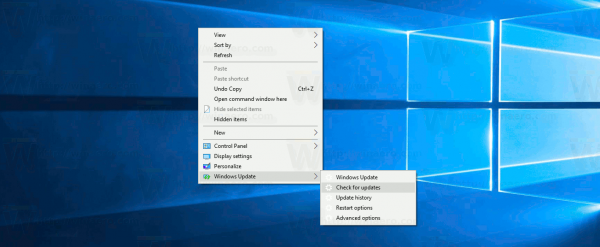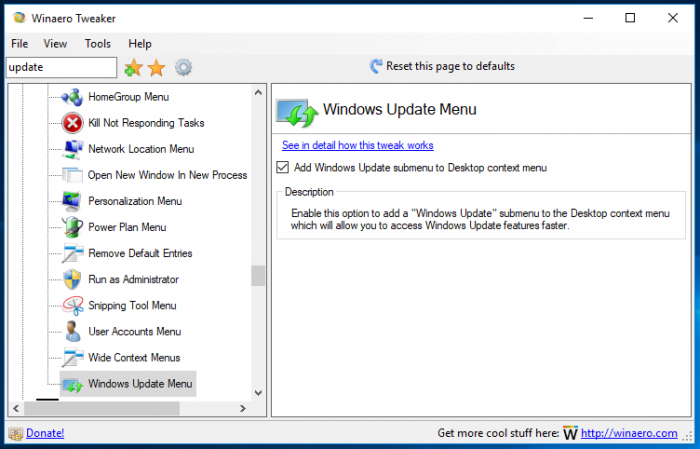Windows 10 is set to check for updates automatically unless you disable this feature manually. Sometimes you need to change its settings, manually check for updates or view the update history in Windows 10. You can save your time and add a Windows Update context menu to Desktop to access Windows Update features faster.

You can add a special submenu "Windows Update" to the context menu of Desktop in Windows 10. It will include the following items:
Advertisеment
- Windows Update
- Check for updates
- Update history
- Restart options
- Advanced options
All these options are available in Settings, under "Update & recovery", but you will be able to access them much faster using the commands from the context menu. The menu will be available for all users registered in Windows 10 on your computer.
To add Windows Update context menu in Windows 10, do the following.
As you may remember, there is a set of commands in Windows 10 which you can use to open various pages of Settings directly. Refer to the following articles to learn more about them.
- ms-settings Commands in Windows 10 Creators Update
- Open various Settings pages directly in Windows 10 Anniversary Update
- How to open various Settings pages directly in Windows 10
Here is the set of commands we need to add to the context menu of Desktop.
| Windows Update | ms-settings:windowsupdate |
Check for updates | ms-settings:windowsupdate-action |
Update history | ms-settings:windowsupdate-history |
Restart options | ms-settings:windowsupdate-restartoptions |
Advanced options | ms-settings:windowsupdate-options |
To execute these commands, you can type the desired command in the Run dialog (Win + R) or create a shortcut with the following target:
explorer.exe ms-settings:windowsupdate-history
In our case, there is an alternative way to execute the command. I prepared a Registry tweak to add these commands to the context menu:
Windows Registry Editor Version 5.00
[HKEY_CLASSES_ROOT\DesktopBackground\Shell\WindowsUpdate]
"MUIVerb"="Windows Update"
"Icon"="%SystemRoot%\\System32\\shell32.dll,-47"
"Position"="Bottom"
"SubCommands"=""
[HKEY_CLASSES_ROOT\DesktopBackground\Shell\WindowsUpdate\Shell\01WindowsUpdate]
"MUIVerb"="Windows Update"
"Icon"="%SystemRoot%\\System32\\bootux.dll,-1032"
"SettingsURI"="ms-settings:windowsupdate"
[HKEY_CLASSES_ROOT\DesktopBackground\Shell\WindowsUpdate\Shell\01WindowsUpdate\command]
"DelegateExecute"="{556FF0D6-A1EE-49E5-9FA4-90AE116AD744}"
[HKEY_CLASSES_ROOT\DesktopBackground\Shell\WindowsUpdate\Shell\02CheckForUpdates]
"MUIVerb"="Check for updates"
"Icon"="%SystemRoot%\\System32\\bootux.dll,-1032"
"SettingsURI"="ms-settings:windowsupdate-action"
[HKEY_CLASSES_ROOT\DesktopBackground\Shell\WindowsUpdate\Shell\02CheckForUpdates\command]
"DelegateExecute"="{556FF0D6-A1EE-49E5-9FA4-90AE116AD744}"
[HKEY_CLASSES_ROOT\DesktopBackground\Shell\WindowsUpdate\Shell\03UpdateHistory]
"MUIVerb"="Update history"
"Icon"="%SystemRoot%\\System32\\bootux.dll,-1032"
"SettingsURI"="ms-settings:windowsupdate-history"
[HKEY_CLASSES_ROOT\DesktopBackground\Shell\WindowsUpdate\Shell\03UpdateHistory\command]
"DelegateExecute"="{556FF0D6-A1EE-49E5-9FA4-90AE116AD744}"
[HKEY_CLASSES_ROOT\DesktopBackground\Shell\WindowsUpdate\Shell\04RestartOptions]
"MUIVerb"="Restart options"
"Icon"="%SystemRoot%\\System32\\bootux.dll,-1032"
"SettingsURI"="ms-settings:windowsupdate-restartoptions"
[HKEY_CLASSES_ROOT\DesktopBackground\Shell\WindowsUpdate\Shell\04RestartOptions\command]
"DelegateExecute"="{556FF0D6-A1EE-49E5-9FA4-90AE116AD744}"
[HKEY_CLASSES_ROOT\DesktopBackground\Shell\WindowsUpdate\Shell\05AdvancedOptions]
"Icon"="%SystemRoot%\\System32\\bootux.dll,-1032"
"MUIVerb"="Advanced options"
"SettingsURI"="ms-settings:windowsupdate-options"
[HKEY_CLASSES_ROOT\DesktopBackground\Shell\WindowsUpdate\Shell\05AdvancedOptions\command]
"DelegateExecute"="{556FF0D6-A1EE-49E5-9FA4-90AE116AD744}"Notice the SettingsURI string value. It tells the shell to execute the Settings app and go to the specified page directly! A special object {556FF0D6-A1EE-49E5-9FA4-90AE116AD744} called from the command subkey performs the operation. So, the pages of the Settings app will be opened natively.
The context menu commands "Personalization" and "Display" work exactly this way, and this is how I discovered the trick. The User Accounts context menu also utilizes it.
You can enable or disable the Windows Update context menu quickly using Winaero Tweaker. It comes with the following UI:

Download the app from here: Download Winaero Tweaker
To save your time, I prepared ready to use Registry files which you can download here:
The undo file is included, so you can add or remove the Windows Update submenu quickly.
Support us
Winaero greatly relies on your support. You can help the site keep bringing you interesting and useful content and software by using these options:

Thanks Sergey! Very helpful! Hope this makes it into Winaero too. :)
Sure I will do.
Very useful and thanks.
On testing all sub menus work as intended, except for “Advanced Options” (ms-settings:windowsupdate-options). It takes me to the main Windows Update Settings page instead. I’ve looked at the code, it looks as the others with the acception of the needed changes.
Any ideas?
Available commands are (reference):
Update & security
Windows Update ms-settings:windowsupdate
Check for updates ms-settings:windowsupdate-action
View update history ms-settings:windowsupdate-history
Restart options ms-settings:windowsupdate-restartoptions
Advanced options ms-settings:windowsupdate-options
Change active hours ms-settings:windowsupdate-activehours
Optional updates ms-settings:windowsupdate-optionalupdates OR ms-settings:windowsupdate-seekerondemand